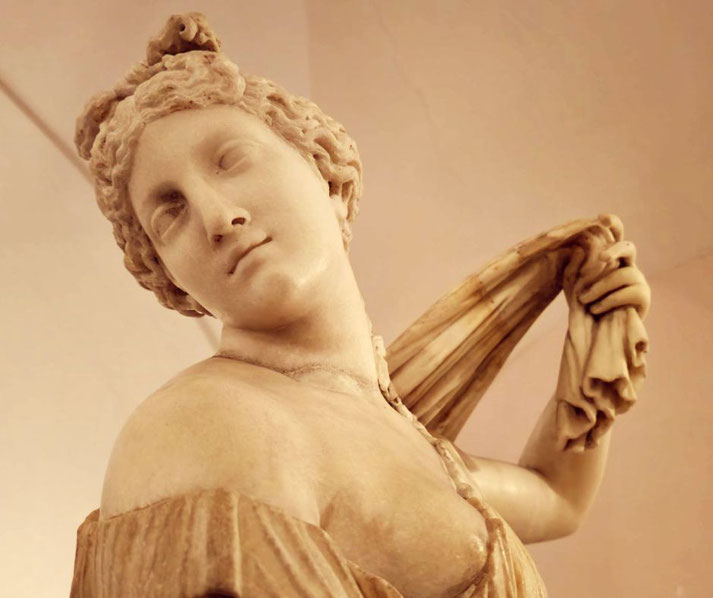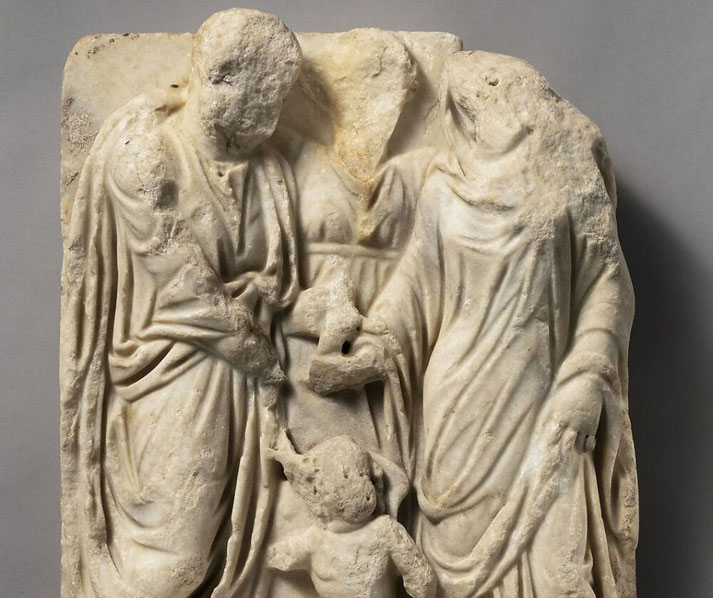Marriage in ancient Rome had very little to do with love but was much more sinister

Marriage in ancient Rome was a complex interplay of societal norms, cultural practices, and legal mandates. For Romans, marital unions went beyond personal connections or romantic inclinations; they were instruments of social stability, political alliances, and economic advancement.
From the solemn rituals of engagement to the multifaceted wedding ceremonies, each step was imbued with symbolism and purpose, revealing much about the values and priorities of Roman society.
The strict Roman rules around marriage
Central to understanding Roman marriage was the concept of "manus." Manus signified the authority under which a woman found herself after marriage.
If she was in "cum manu" marriage, she left her birth family and entered her husband's legal authority, almost as if she became one of his possessions.
Conversely, "sine manu" marriages allowed the wife to remain under her birth family's authority.
The legal distinction between "matrimonium" and "contubernium" was also pivotal.
Matrimonium referred to a legally recognized union, often between citizens or between a citizen and a legal resident.
This union was considered legitimate and carried with it certain legal rights and obligations.
On the other hand, contubernium referred to a relationship often seen between slaves or between a slave and a free person.
It lacked the legal recognition and privileges associated with matrimonium.
Additionally, there were specific age requirements for marital unions. For males, the minimum age was around 14, while for females, it was around 12.
These age limits, however, were often guidelines rather than strict mandates, and exceptions existed based on social class and other factors.

How people got married in ancient Rome
Ancient Roman marriage ceremonies were characterized by a plethora of rites and rituals, each laden with deep symbolism and reflective of the prevailing cultural values of the time.
At the onset, an engagement ritual set the stage. Here, the couple exchanged rings, often gold, worn on the third finger of the left hand, believed to be directly connected to the heart by the 'vena amoris' or 'vein of love'.
The wedding day itself was steeped in a series of specific customs. One of the most emblematic was the bride's attire.
She would don a saffron-colored tunic and a flame-colored veil, known as the "flammeum", believed to bring good fortune and ward off evil spirits.
This vivid attire was complemented by the bridal hairstyle, which featured six intricate braids, representing the dedication and discipline of a Roman matron.
A pivotal moment during the ceremony was the "dextrarum iunctio", the joining of the couple's right hands, symbolizing their union and shared commitment.
Overseeing this union was the pronuba, usually a woman who had been married only once and was still with her husband.
Her role was to guide the bride's hand into her groom's, acting as a bridge between the bride's maidenhood and her impending status as a wife.
Following the hand joining, the couple would offer sacrifices to the gods, especially Juno, the protector of marriage.
Once the religious aspects were completed, there was a public declaration of the marriage contract, which was traditionally written on a tablet.
The real reason many Romans got married
The significance of marital unions extended well beyond the couple, shaping the very fabric of Roman society.
Economically, the institution of dowries exemplified the weighty financial undertones of marriage.
A dowry, typically provided by the bride's family, was a significant sum or property transferred to the groom upon marriage.
This dowry wasn't just a simple transaction but represented a family's wealth, status, and strategic positioning within the broader Roman community.
Marriages, particularly among the upper echelons of society, were often tools of consolidation, designed to bring together powerful families, safeguard assets, and ensure the continuation of family legacies.
These unions were meticulously planned to ensure not only familial compatibility but also economic and political advantage.
Such strategic alliances through marriage could fortify one's political standing, expand territorial holdings, or strengthen trade ties.
In terms of social dynamics, marriage played a pivotal role in defining individual status and societal roles.
A Roman matron, for instance, was expected to manage household affairs, oversee slaves, raise children, and often engage in specific social and religious roles.
The success of a marital household, especially in terms of producing heirs, was a direct reflection of a family's standing in the community.
A family without heirs risked economic instability and a potential decline in social stature.
What about marriage among poorer Romans?
For the elite patrician class, marriages were highly strategic. They were instruments of consolidation, orchestrated to amass wealth, secure political alliances, or bolster social prestige.
These unions, often arranged by family heads, were less about personal compatibility and more about familial advantage.
Dowries in these circles were lavish, reflecting the substantial assets and holdings of both families.
Despite the calculated nature of such alliances, affection and love could develop over time, with couples forming genuine bonds.
The plebeians, or common citizens, had a different marital experience. While economic and social benefits still played a role in marriage decisions, personal preference and compatibility held more weight.
Dowries were modest compared to the upper classes, and rituals, while still important, were less grandiose.
The mutual agreement, "consensus," was paramount, emphasizing the personal and voluntary nature of plebeian unions.

At the lowest rung of the societal ladder were the slaves. Technically, slaves couldn't enter into a recognized marriage, given their status as property.
However, they formed partnerships known as "contubernium," which, while lacking legal status, represented a bond of commitment.
Masters sometimes encouraged these unions, especially if they wanted to produce more slaves.
Upon gaining freedom, former slaves, now freedmen, could legally marry, and they often did so with the partners they had during enslavement.
The role of religion in Roman marriages
From the outset, various deities were invoked to bless and oversee Roman marriages.
Juno, for instance, was the goddess of marriage and childbirth, and her blessings were fervently sought.
Her various epithets, such as Juno Lucina, who safeguarded childbirth, highlighted the multifaceted role she played in the marital journey.
Additionally, Hymen, the god of wedding ceremonies, was invoked to ensure a joyous and prosperous union.
The rituals and ceremonies accompanying a Roman marriage were deeply rooted in religious tradition.
The auspices, or divine signs, were often sought before significant events, including marriages, to ensure the gods' favor.
These divine readings could influence the timing and conduct of wedding ceremonies.
On the day of the wedding, sacrifices were made to various deities, and prayers were recited, seeking divine blessings for the couple's future.
Religious rites also extended to the household. The "lararium," a shrine dedicated to the household gods or "Lares," played a central role in daily Roman life.
The newlywed couple would often make offerings to these deities, seeking protection and prosperity for their new household.
Furthermore, the concept of "sacra privata" — the private religious practices and rituals of a family — held considerable weight.
When a woman married, she transitioned from the sacra of her birth family to those of her husband's family.
This shift wasn't just symbolic but was a genuine transition of religious and familial duties and allegiances.
Could people get divorced in ancient Rome?
Divorce in ancient Rome was a practice that, while not frequent, was socially and legally acknowledged and quite distinct from many other ancient civilizations in its relative ease and accessibility.
The Romans' pragmatic approach to marriage, where unions were often seen as economic and social contracts, extended to their perspective on divorce.
If a marriage failed to serve its societal or personal purposes, it could be dissolved.
Legally, the process was straightforward. Roman marriage was based on mutual consent, and similarly, divorce required only the intention of one or both parties to end the union.
There was no necessity for a legal process or judicial decree. Often, a public declaration or a written statement was sufficient to declare the end of a marriage.
In some cases, especially where property and assets were involved, there might be further documentation or settlements, but the lack of complex legal procedures made Roman divorce relatively uncomplicated.
Several reasons could lead to divorce. Infidelity, barrenness, or simply the desire to enter a more advantageous marriage could be grounds.
Men had the upper hand in initiating a divorce, but women too had the right to separate from their husbands, especially if there was a justifiable reason.
One of the most famous instances is that of Cicero, the Roman orator, who divorced his wife Terentia after a long marriage, citing financial dishonesty.
Economically, a primary concern surrounding divorce was the dowry.
Originally given to the groom at the start of the marriage, the dowry was expected to be returned to the wife or her family upon the dissolution of the marriage.
However, this didn't always happen without contention, leading to occasional disputes.
Socially, while divorce was not stigmatized as it was in some other cultures, it wasn't entirely devoid of repercussions.
A woman who sought a divorce, particularly without a compelling reason, could face social censure.
Moreover, while men faced fewer societal judgments, repeated divorces could harm a man's reputation, casting doubt on his reliability and character.
What do you need help with?
Download ready-to-use digital learning resources
Copyright © History Skills 2014-2025.
Contact via email
With the exception of links to external sites, some historical sources and extracts from specific publications, all content on this website is copyrighted by History Skills. This content may not be copied, republished or redistributed without written permission from the website creator. Please use the Contact page to obtain relevant permission.





